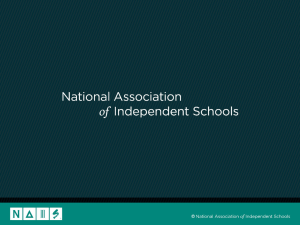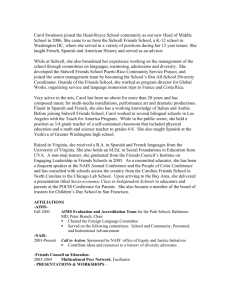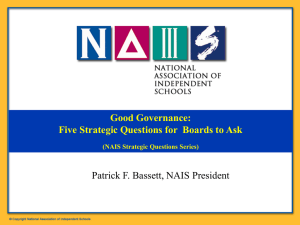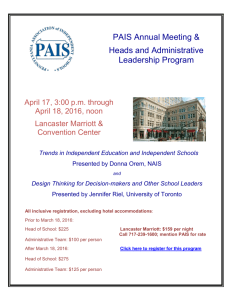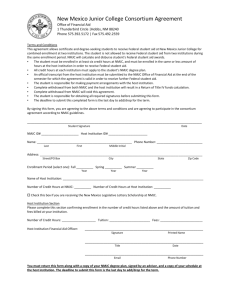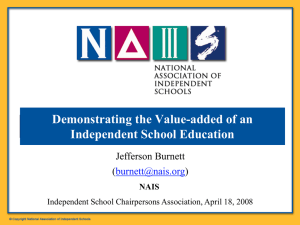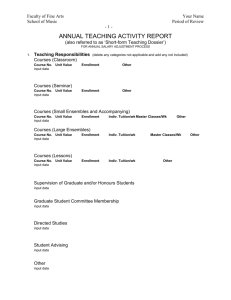Slide 1
advertisement
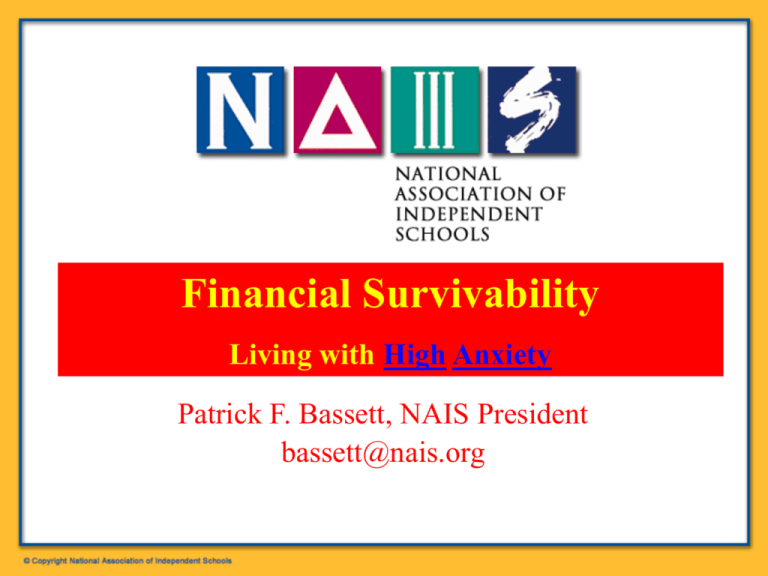
Financial Survivability Living with High Anxiety Patrick F. Bassett, NAIS President bassett@nais.org http://www.nais.org/resources/movie.cfm?ItemNumber=151365&Token=0ABC75DE-F155-4A36-931E-95A3A428ECD4&field1=value1&field Play clip My faculty members are very anxious about the economy’s impact on their jobs. Instant Poll at NAIS Annual Conference, 02/26/09 41% 1. Strongly Agree 2. Agree 3. Neutral 23% 21% 4. Disagree 13% 5. Strongly Disagree 3% 1 2 3 4 5 Financial Sustainability? Finanicial Survivablity in an Economic Meltdown Patrick F. Bassett, NAIS President Brutal Facts vs. Unshakeable Beliefs The “Perfect Storm”: Six Factors in Confluence. What Shape is your Strategic Plan in? 1. Enrollment Shaky (or Worry about Next Year): For some schools this, year, higher than usual summer attrition and lower than usual enrollments resulting in a shortfall of students, in some cases up to fifty off budget. Universal worry about next year and thereafter. See NAIS monthly pulse surveys on admissions funnel to track industry patterns. 2. Financial Aid Demand Growing: Current families of higher incomes starting to demand and qualify for financial aid as tuitions have skyrocketed while family salaries remain flat and equity in homes and investments tanks. The “Perfect Storm” 3. Debt Service Rising/Endowment Income Falling: Those with variable bond rates saw their rate soar from 3% to 10% in some cases, impacting heavily and unexpectedly the current year budget’s debt service obligations. Even for schools with fixed rate bonds, some found their Debt:Endowment ratio “under water,” with value of endowments and income from endowment plummeting, impacting their liquidity and capacity for borrowing. 4. Demographics Changing: In the number of school-age children in many locales where independent schools are located as housing stock and cost of living become prohibitively expensive for young families. The “Perfect Storm” 5. Affordability Disappearing as Tuitions Skyrocket: A climate of caution where even families with substantial dual incomes fear a job loss could bring financial catastrophe, making independent school tuition, heretofore considered a necessity, all of a sudden considered a discretionary luxury. NAIS School Search Trends Survey 2009: IECA Consultants seeing a drop off in interest and growing fears by families regarding their capacity to pay for our schools. ISM Re-enrollment Survey Jan 2009: Some shakiness. 6. Wealth Declining: A chilling zephyr on feelings about one’s wealth and capacity for eleemosynary giving. See NAIS monthly pulse surveys on annual giving to track industry patterns. But…. Are we the harbor during the storm? Is private school a luxury or necessity? What are the lessons from the past? The early indicators? NAIS Schools Holding on during Recessions Recession Years (in Avg Enrollment Annual Giving per Red) Student (unadjusted $) 1968-69 1969-70 1970-71 339 345 337 $ 170 $ 147 $ 150 1972-73 347 $ 203 1973-74 1974-75 1975-76 359 361 360 $ 220 $ 203 $ 173 NAIS Schools Holding on during Recessions Recession Years (in Avg Enrollment Annual Giving per Red) Student (unadjusted $) 1979-80 387 $ 267 1980-81 1981-82 390 397 $ 420 $ 313 1989-90 1990-91 1991-92 403 408 414 $ 862 $ 875 $ 907 NAIS Schools Holding on during Recessions Recession Years (in Avg Enrollment Annual Giving per Red) Student (unadjusted $) 2000-01 487 $ 1,248 2001-02 2002-03 485 482 $ 1,273 $ 1,343 SSAT Test Volume as of 1/15/09: October test up 8%; November test up 1.5%; December test up 2.9%; January test down 13.5%; SSS Apps: Up 6.6% compared to last year. Giving: Overall in the US, giving goes up every year, even during recessions. During recessions it goes up in three out of four sectors: Church, Social Services, Arts, Colleges. Admissions Funnel Stable for NAIS Schools, over Time (except inquiries down 20%) Prior Year Number Number Average Average Average Funnel Schools Inquiries Applicants Accept Enrollees 2009-09 1129 724 278 143 96 2007-08 996 714 287 146 97 2006-07 965 754 282 145 99 2005-06 967 797 280 147 99 2004-05 951 819 278 149 98 2003-04 916 856 285 150 98 2002-03 805 929 311 155 103 2001-02 899 975 318 151 103 2000-01 835 1061 329 153 104 1999-00 809 1038 319 154 106 1998-99 855 991 296 148 103 1997-98 869 998 296 147 102 Average Enrollments at NAIS Schools Stable over Time Year # Schools Totl Enrolment Avg Enrolment 2001 1,218 551,944 453 2002 1,688 744,342 441 2003 1,534 627,230 409 2004 1,523 606,551 398 2005 1,656 660,479 399 2006 1,492 645,916 433 2007 1,491 650,895 437 2008 1,468 670,139 456 2009 1,493 681,762 457 Spikes = Beyond the normal 6% increase NAIS Monthly “Pulse Surveys” • Signed Enrollment Contracts: 67% (2009-10 academic year through March as a % of last year total) • Annual Gifts: 74% (2008-09 fiscal year through March as a % of last year total) • Signed Enrollment Contracts: 94% (2009-10 academic year through April as a % of last year total) • Annual Gifts: 82% (2008-09 fiscal year through April as a % of last year total) • Note: Since many if not most schools have budgeted for somewhat fewer students, many if not most schools are already close to budget targets for enrollment. Since many if not most schools budgeted for higher annual giving (before the market collapse), many if not most schools may fall short of this year’s goal. An NAIS Overview Framework There are no “one-armed” economists: Acknowledge and reconcile yourself functioning in a climate of uncertainty. Recognize that each school faces many unique circumstances, so no generalities will apply to all. Hope for the best but plan for the worst: Create three financial contingency plans: best case, worst case, most likely case. An NAIS Overview Framework Don’t waste the motivation of crisis to fast-forward to a more financially sustainable future: trim fat and waste; dry-dock programs that no longer are viable; go green fast; moderate tuition increases and spike financial aid; grow school in down market by aggressive net tuition discounting or merit aid. Communicate to your constituents about school finances, the value proposition, and the importance of giving. The Financial Crisis - : “First Response” Moves, Fall ‘08: 1. Endowment: Most School Sat tight to ride out the storm. Financial Consultant: "Investments have historically yielded positive results to investors who bought when others were fearful, sold when most others were euphoric, and stood their ground when the situation was unclear. While past performance does not guarantee future results, one defense against short-term fear is long-term confidence." 2. Cash: “Trust in God…but tie your camel.” Most schools had or put cash in FDIC-insured savings or brokerage accounts, despite the low rates of return. The Financial Crisis : “First Response” Moves, Fall ‘08: 3. Debt-Financed Bonds: Many schools became cautious about initiating borrowing. Jeff Lewis (lewis@icemiller.com) “Not a great time to begin a bond-financed campaign…. (If you do—go with a strong bank’s letter of credit.) For those that are already impacted by the credit crunch and related fall-out, there is not a single source of guidance: Remain in close contact with banking partners, bond counsel, and government regulators.” 4. Financial Planning: Many schools began creating a 3Scenario Plan Framework: NAIS’s suggestion: Best Case: +/- 3-5% (based on historical fluctuations in normal times) Worst Case: Down 20% or more Most Likely: Down 5 -10 % (Down in enrollment, budget, and giving) Which outcome best describes what you anticipate for next year for your school in terms of enrolment, budget, and giving? Instant Poll at NAIS Annual Conference, 02/26/09 55% 1. Up or down 3-5% 2. Down 5% – 10% 36% 3. Down 20% or more 4. Some other outcome 8% 2% 1 2 3 4 A 10-Rung Ladder of Contingencies: Ideas from NAIS and the Field Cut Expenses (Except Increases for Financial Aid and maintaining budgets for marketing and advancement): 1. Freeze “non-defense spending”: i.e., put a hold on discretionary expenditures. 2. Postpone capital expenditures: e.g., capital renovations and replacements. 3. Double up assignments to cover staff attrition: rather than hiring replacements. A 10-Rung Ladder of Contingencies: Ideas from the Field 4. Go “green” fast: Recommendations from the NBOA and NAIS listserves and the field… implement dramatic conservation strategies (the 3 Rs of reduce, re-use, and recycle); re-structure athletic and field trip travel schedules; adopt policies to reduce electricity and oil/gas consumption; incentivize use of public transportation and ride-sharing; listen to your business manager and maintenance director and environmental science faculty on other savings possibilities; see NAIS’s piece on “100 Ways To Go Green and Global”. A 10-Rung Ladder of Contingencies: Ideas from the Field 5. Moderate tuition increases: While expanding financial aid budgets (to meet increased need of current and future families) 6. Moderate salary increases: Some schools offering stepped sequencing, offering frozen salary now, then bump up for COL or COL+ contingent upon achieving balanced budget enrollment projections. A 10-Rung Ladder of Contingencies: Ideas from the Field Increase Income: 7. Use net tuition discounting (and consider merit aid) to grow enrollment without adding staff. (Restricted to new students.) 8. Raise more money by strengthening advancement messaging and cultivation. 9. Fully utilize the school’s physical capital (expanding use of campus) 10. Exploit the schools intellectual capital by creating related businesses: online courses, tutoring services, boarding program for international students, etc. Higher Risk Options: Borrowing more (risking exacerbating debt service demands: if necessary, “borrow from yourself,” using reserves and endowment with a formal payback schedule). Abandoning your spending policy, taking a larger draw from the endowment that invades principal (risking jeopardizing standing with donors) Committing publicly now to very ambitious capital campaign goals (risking timing and attainability issues) A Financial Disaster Plan Disaster Plan: Income down 20% or more. 1. Maintain full services by making a heroic commitment, to the extent possible, the Katrina model of being the one safe harbor in the storm for kids and parents. 2. Right-size the school: Downsize staffing = “rightsizing”: toward a more financially sustainable ratio of students:staff, a one-time opportunity to prune the shrub so it can grow back strongly. 3. Merge: Necessity being the mother of invention, under dire circumstances the idea of merging neighboring independent schools together begins to look more attractive and less impossible. “Unshakeable Beliefs” Counter “Brutal Facts” 1. We have the freedom to act quickly and decisively when needed, since we are effectively independent of government or church in our governance and finance. 2. We have the capacity to act with resources behind us since we have intellectual, physical, and social capital, unmatched by any other PS-12 segment. 3. Industry leaders have confidence our schools “will not only endure but prevail,” since history is on our side: If any institutions are “built to last,” it is independent schools. (Faculty, trustees, and parents need reassurance: high anxiety levels.) “Unshakeable Beliefs” Counter “Brutal Facts” Within challenges, lie opportunities to make… 1. A dramatic commitment school by school to sustainability financially, environmentally, demographically, programmatically, and globally. 2. A transition from our truculent insistence on independence to a more efficient openness to interdependence as we collaborate with other schools and other sectors to market ourselves, to share resources, and to co-create 21st. C. schools. “Unshakeable Beliefs” Counter “Brutal Facts” Within challenges, lie opportunities to make… 3. A paradigm shift (“Scarcity and Privilege” –Peter Cobb): What’s “required" in the architecture of our schools and in the architecture of our lives”? To recognize that “to live life abundantly, this generation of young people does not need to live” wastefully, and “to live life richly, this generation of young people does not have to consume” ceaselessly. The Leadership Part: Many of the people we need to make all of this happen are in the room. CASE STUDIES 1. What are what Harvard’s Jim Honan invites, the “deeper conversations” and "beyond the usual" responses? Or James Surowiecki’s “wisdom of the crowd?” 2. One school’s plan: rather than cut back, spend endowment and use aggressive merit aid to grow school enrollment and program as competitors contract. 3. Another school’s plan: YES (“Year Entry Set Tuitions”): Freezing tuitions at entry point for four years. Small School Case Study: 3-Scenario Budgeting: Benchmark School Comparison: Best Case,2008-2009 Worst Case, Most Likely Benchmark Schools (20082009) Grade K Tuition Grade 3 Tuition Grade 6 Tuition Grade 8 Tuition Starting Teacher Salary Highest Teacher Salary Mean Salary Median Salary School 1 $15,382 $15,382 $16,082 $16,082 $31,662 $75,625 $58,693 $55,739 School 2 $10,350 $10,650 $10,950 $11,150 $28,000 $48,045 $39,286 $40,565 School 3 $14,500 $14,500 $14,700 $15,000 $33,391 $65,755 $51,518 $51,239 School 4 $13,640 $13,640 $13,640 $13,640 N/A $58,275 $42,271 $42,790 School 5 $15,800 $15,800 N/A N/A $31,600 $44,400 $38,720 $42,800 School 6 $9,475 $9,750 $9,750 $9,750 $20,000 $40,000 $30,000 $31,929 Our School $12,980 (5/7)* $12,980 (5/7) $13,680 (3/6) $13,680 (3/6) $30,500 (4/6) $47,950 (5/7) $37,081 (6/7) $36,400 (6/7) *( our school/pool) = Our School Rank Forecast Budget Scenarios 2009-2010 TOTAL STUDENTS Lower School:Middle School % Tuition Increase $ Tuition Increase LS Tuition MS Tuition 190 145:45 7% +$920:$990 13900 14850 210 155:55 7% +$920:$990 13900 14850 225 168:57 7% +$920:$990 13900 14850 2683750 -47500 -55500 -402563 710730 2888917 2971250 -47500 -55500 -445688 710730 3133292 3181650 -47500 -55500 -540880 710730 3248499 1164052 1824187 273700 28350 -24250 -3266039 1164052 1824187 273700 28350 -24250 -3266039 1164052 1824187 273700 28350 -24250 -3266039 Net Depreciation -377122 208727 -132747 208727 -17539 208727 Mortgage Principal PPRSM Lease Med Plan Benefit Capital Expenditures -185634 14000 -15000 -10000 -20000 -185634 14000 -15000 -10000 -20000 -185634 14000 -15000 -10000 -20000 CASH FLOW +/- -385029 -140654 -25446 REVENUE Total Tuition Revenue Tuition Discount Sibling Discount @$500/child Financial Aid 15%/Total Revenue Other Revenue Total Revenue EXPENSES General (+3%) Salary (+3%) Medical Benefit (+15%) Insurance (+5%) Mortgage Interest Total Expenses Mitigation Options: Expense Cuts: •Professional Development 50K •Leadership Stipends 25K •TIAA Contribution 35K •Marketing 15K •Salary @ 210 2x35K = 70K @ 190 5x35K = 175K • Close 1 Building: @190 TOTAL: 355K 55K 195 to Revenue Enhancement: •Summer Camp •Fundraising +15K Our School: Enrollment Scenarios 2009-2010 Enrollment 190 (Worst Case: Down 20%) Grade Sections 210 (Most Likely: Down 10%) # Students Grade Sections # Students 225 (Best Case: No Change or +/- 3-5% ) Grade Sections # Students PK 1 18 PK 1 18 PK 2 22 K 2 26 K 2 28 K 2 30 1 2 24 1 2 28 1 2 30 2 1 18 2 2 22 2 2 25 3 2 24 3 2 28 3 2 29 4 1 18 4 2 20 4 2 20 5 1 18 5 2 20 5 2 20 6 1 18 6 1 20 6 1 21 7 1 11 7 1 11 7 1 13 8 1 15 8 1 15 8 1 15 190 210 225 Financial Sustainability/Survivability The End! (See related slides in Appendix) Return Private School: Luxury or Necessity? Coloradans deal with the recession diet By Kevin Simpson and Michael Booth, The Denver Post (from January 21, 2009) (Denver, CO) – “Shrinking family incomes, the market's free-fall and fearsome financial forecasts have forced consumers to confront the real difference between what they need to live and what they can live without. Interviews with experts and individual consumers confirmed findings of an unscientific Denver Post e-mail poll of 69 Coloradans that found 70 percent have given up some luxury they once regarded as a necessity. They were asked to choose the easiest to jettison — and the hardest. Hardest To Give Up: 1. Cable TV/Internet 2. Private School …tied with #3… 3. Vacation 4. Hairdresser 5. Gym Membership ISM Re-enrollment Survey January 2009 Household Income Distribution Gross annual income Cumulativ Each Group e # Respondents Under $40,000 4.1% 4.1% 551 $40,001 - $75,000 16.6% 12.4% 1653 $75,001 - $125,000 40.2% 23.6% 3136 $125,001 - $175,000 56.3% 16.1% 2145 $175,001 - $225,000 65.9% 9.6% 1272 $225,001 - $275,000 72.1% 6.2% 820 $275,001 - $325,000 76.0% 4.0% 528 $325,001 - $375,000 78.3% 2.3% 303 $375,001 - $425,000 81.0% 2.7% 363 $425,001 or greater 89.6% 8.6% 1144 No Answer 100.0% 10.4% 1376 Totals 100.0% 13291 Families >$100K: 20% send to private schools (vs. 10% overall) (US Census) http://www.census.gov/population/www/socdemo/school/cps2005.html Varying by region, 4%-9% indicate “will not or probably not stay” “Leaner Times at Independents”—Washington Post, 3/2/09 “As Economy Tanks, Schools Seek Survival Tactics” – Jewish Journal, 1/28/09 “Private schools put big price tag on education”-- Tufts Daily, 2/4/09 “Private Schools Feel the Pinch Amid Recession”—Wall Street Journal, 1/26/09 “Economic downturn causes worries for private schools”—New Orleans TimesPicayune, 1/31/09 "Recession Hits Private Schools" – Crain’s New York Business, 2/11/09 “Student Base Shrinking for Local Private Schools” – Santa Maria Times, 2/11/09 http://www.workforce.com/section/11/feature/26/20/01/ NAIS Schools Data on Non-need Merit Aid: School Year 2008-09 28% of schools now offering merit aid. 5% of all aid recipients.
